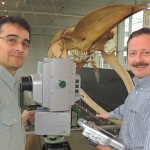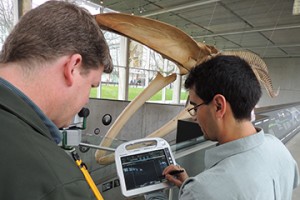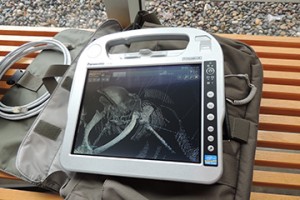
Tuesday, March 31st, 2015
Staff from the Maptek Vancouver office used an I-Site 8820 laser scanner to capture a blue whale skeleton housed at the Beaty Biodiversity Museum at the University of British Columbia recently.
The demonstration was part of a 3D spatial imaging presentation to geology students at the University. In total 11 scans were taken and over 33 million data points captured.
The point cloud data was modelled in I-Site Studio to create an accurate 3D representation of the skeleton. High definition photographs captured simultaneously by the I-Site 8820 laser scanner ensure the model appears exactly as the skeleton does to the naked eye.
Maptek was invited to the university to introduce geology students to the geological and geotechnical capabilities of laser scan survey technology. Kono Rodriguez and Brent Buchan took the students through an interactive presentation, highlighting the powerful combination of I-Site hardware and software.
The Beaty Biodiversity Museum specimen is one of only 21 blue whale skeletons on public view in the world. At 26 metres long, it is the largest blue whale skeleton on display in Canada.
Click the video below to see the 3D model of the blue whale skeleton.
ReCAPTCHA has failed to load! Try reloading the page to submit this form. ReCAPTCHA no se ha podido cargar. Intente volver a cargar la página para enviar este formulario. Não foi possível carregar ReCAPTCHA. Tente recarregar a página para enviar este formulário. Не удалось загрузить ReCAPTCHA. Попробуйте перезагрузить страницу, чтобы отправить эту форму.


